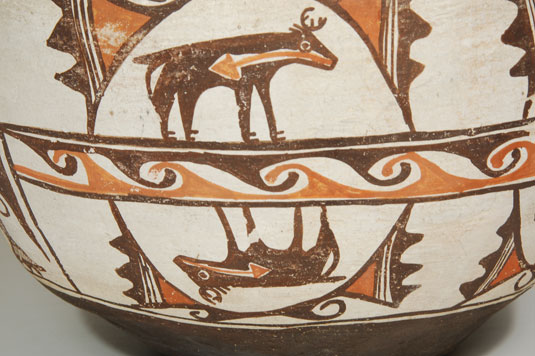Zuni Pueblo Olla with an Upside Down Deer [SOLD]
+ Add to my watchlist Forward to Friend
- Category: Historic
- Origin: Zuni Pueblo, SHE-WE-NA
- Medium: clay, pigment
- Size: 9-3/4” height x 11-1/4” diameter
- Item # C3804A SOLD
Assigning a date to Zuni Pueblo historic pottery is facilitated by the very large number of Zuni vessels collected for the Bureau of American Ethnology between 1879 and 1885, and by those collected for the American Museum of Natural History between 1899 and 1912.
Sometime before 1870, potters began to paint their vessels’ underbodies and the interiors of their necks black. In early cases, black was applied over the interior’s red neck paint. In those vessels, the red is faintly visible through the black. Of course, a change of this nature did not occur overnight but may have occurred over several decades. It is believed that the change on the neck interior was completed by 1865. It was not until around 1900 that the underbody caught up with the neck.
The very pronounced puki flexure on earlier Zuni jars changed over time to a less pronounced one. Puki lines are noticeable as late as 1920 but not afterwards.
Zuni jars made after 1850 display a more elaborate design on the body and a more repetitive design on the neck. The body design that became prominent around 1870 features two large design panels in a horizontal layout and two smaller panels in a vertical layout. The larger panels are divided in half by a horizontal band containing simple birds with elaborate tails or wave-like scrolls. Above and below the horizontal bands are floral designs or heart line deer. The vertical panels feature non-plant and non-animal designs such as volutes or arrowheads.
Neckband designs on Zuni Polychrome jars seem to be standard over decades with very little freedom for the potter to innovate. Double-ended scrolls and a dagger element predominate.
Based on these and other documented designs, it is probable that this large Zuni Polychrome jar slightly predates 1900. The interior neck is painted black to a depth of 1/2-inch, the underbody is black. There is a definite, although not too pronounced, puki flexure. The design is separated into neck and body, with the body consisting of deer in upper and lower frames. Dividing the upper and lower row of deer is a band of red and black interlocking scrolls or waves.
The deer are the most interesting aspect of the design. All of the deer on the upper panel are facing east and all the ones on the lower panel are facing west. One deer on the lower panel is upside down!
The vertical panels on the body have a circle outlined by black caps. Above and below the circle are crown-like elements in heavy black. There is no red in these vertical panels.
One could speculate as to why the potter placed one deer upside down. Was it just a moment of playfulness or perhaps a family’s signature design? The reason remains unknown but the effect is intriguing and charming.
Condition: structurally in very good condition with some abrasions to the painted surface.
Provenance: from a family in New Mexico that is moving to Colorado and chose not to take this jar with them.
Recommended Reading: The Pottery of Zuni Pueblo by Harlow and Lanmon

- Category: Historic
- Origin: Zuni Pueblo, SHE-WE-NA
- Medium: clay, pigment
- Size: 9-3/4” height x 11-1/4” diameter
- Item # C3804A SOLD



